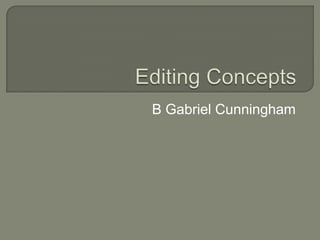
Editing concepts
- 2. A shot reverse shot is usually used during convocations or when a character analysis an object. During convocations the camera looks at the one speaking and goes back and forth between the two. However if its an object it tends to focus in more and more for every shot reversed. This is a sequence from The Stendhal Syndrome
- 3. A cut obeying the axis of action principle, in which the first shot shows a person off in one direction and the second shows a nearby space containing what he or she sees. If the person looks left, the following shot should imply that the looker is off-screen right. As her interest grows, the eye line match (that is the connection between looker and looked) is stressed with matching close-ups of Anna's face and Icarus's falling into the ocean in the painting. Again, this implies that Anna is looking directly at Icarus's body.
- 4. A cut which splices two different views of the same action together at the same moment in the movement, making it seem to continue uninterrupted. Quite logically, these characteristics make it one of the most common transitions in the continuity style editing.
- 5. An approach to editing developed by the Soviet filmmakers of the 1920s such as Pudovkin, Vertov and Eisenstein; it emphasizes dynamic, often discontinuous, relationships between shots and the juxtaposition of images to create ideas not present in either shot by itself. Sergei Eisenstein, in particular, developed a complex theory of montage that included montage within the shot, between sound and image, multiple levels of overtones, as well as in the conflict between two shots. This sequence from October (Oktyabr, USSR, 1927) is an example of Eisenstein's intellectual montage. Soviet Montage proved to be influential around the world for commercial as well as avant-garde filmmakers.
- 6. Editing that alternates shots of two or more lines of action occurring in different places, usually simultaneously. The two actions are therefore linked, associating the characters from both lines of action. In this extended clip from Edward Yang's Yi Yi (Taiwan, 2000), father and daughter go out on dates at presumably the same time, and go through the same motions. He uses parallel editing across space and time to suggest that history repeats itself, generation after generation.
- 7. A system of cutting to maintain continuous and clear narrative action. Continuity editing relies upon matching screen direction, position, and temporal relations from shot to shot. The film supports the viewer's assumption that space and time are contiguous between successive shots. Also, the diegesis is more readily understood when directions on the screen match directions in the world of the film. The "180° rule," shown in the diagram below, dictates that the camera should stay in one of the areas on either side of the axis of action. By following this rule the filmmaker ensures that each character occupies a consistent area of the frame, helping the audience to understand the layout of the scene. This sense of a consistent space is reinforced by the use of techniques such as the eyeline match or match on action. In the Hollywood continuity editing system the angle of the camera axis to the axis of action usually changes by more than 30 ° between two shots, for example in a conversation scene rendered as a series of shot/reverse shots. The 180° line is not usually crossed unless the transition is smoothed by a POV shot or a reestablishing shot.
- 8. An instantaneous shift from a distant framing to a closer view of some portion of the same space, and vice versa. In Lars Von Trier's Dancer in the Dark ( Denmark, 2000) Selma and Bill have a dramatic conversation in Bill's car that is framed by a cut-in and a cut-away. The two cuts neatly bracket Bill's anguished confession as a separate moment, private and isolated, that only Selma knows about. This editing-constructed secrecy will ultimately have drastic consequences for Selma.
- 9. A shot, usually involving a distant framing, that shows the spatial relations among the important figures, objects, and setting in a scene. Usually, the first few shots in a scene are establishing shots, as they introduces us to a location and the space relationships inside it. In the initial sequence from Peking Opera Blues, director Tsui Hark uses three shots to establish the locale. In the first one, three musicians are shown against a fireplace in what looks like a luxurious room. Our suspicions are confirmed by the second establishing shot, which shows us the other half of the ample room (shot/ reverse shot) and reveals a party going on.
- 10. Two successive shots joined so as to create a strong similarity of compositional elements (e.g., color, shape). Used in transparent continuity styles to smooth the transition between two shots, as in this clip from Women On The Verge Of A Nervous Breakdown (Mujeres al Borde de un Ataque de Nervios, Almodóvar, 1988). A technique used in continuity editing in which the major features of the composition in one shot are duplicated or matched in the next shot, providing a graphic continuity that serves to bridge the edit.